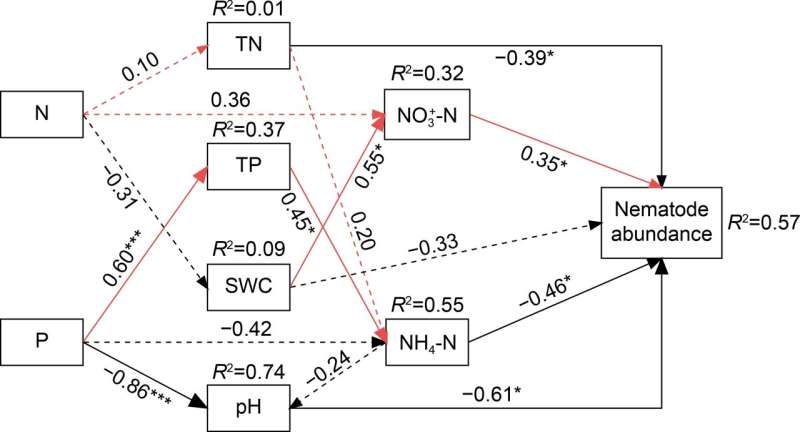This article has been reviewed according to Science X's editorial process and policies. Editors have highlighted the following attributes while ensuring the content's credibility:
fact-checked
proofread
Effects of nitrogen and phosphorus additions on soil nematode community of soybean farmland

As a predator of soil microorganisms, nematodes respond rapidly to changes in soil environment, which can reflect climate conditions, ecosystem succession status, nutrient cycling and soil ecosystem health. In agroecosystems, nitrogen and phosphate fertilizers are often applied in large quantities. Therefore, studying the effect of nitrogen and phosphorus addition on soil nematode communities is helpful to understand how nitrogen and phosphorus addition affects the growth and development of crops in farmland ecosystems.
A study, published in Soil Ecology Letters, demonstrates that the addition of nitrogen and phosphorus significantly increases the abundance of soil nematodes, and nitrogen and phosphorus have an interactive effect.
Yuan Miaoʼs team from the College of Life Sciences of Henan University conducted a series of studies on the effects of nitrogen and phosphorus addition on soil nematodes in farmland ecosystems. They found that phosphorus addition had a more significant effect on soil nematodes than nitrogen addition in farmland ecosystems, and phosphorus addition causes more severe soil acidification.
Professor Miao said, "Compared to field experiments, the pot experiment can help us better understand how nitrogen and phosphorus affect soil nematodes in farmland ecosystems. At the same time, we use soybean crops that are common in our region as our pot plants, which is also helpful for guiding soybean fertilization."
In this study, four experimental treatments were set up, namely control treatment, nitrogen addition, phosphorus addition, and nitrogen and phosphorus addition, which verified the effect of nitrogen and phosphorus addition on soil nematodes in farmland ecosystems and whether nitrogen and phosphorus interacted.
They found that pH, ammonium nitrogen (NH4+-N), and nitrate nitrogen (NO3--N) were the factors that had the greatest influence on soil nematode abundance. Among them, pH and ammonium nitrogen (NH4+-N) had significant negative effects on soil nematode abundance, while nitrate nitrogen (NO3--N) had significant positive effects. This was mainly because the acidic environment was not suitable for nematode survival, and NH4+ was toxic to soil nematodes. They also found nitrogen and phosphorus addition had an interactive effect on soil nematode abundance.
This study can increase our understanding of changes in soil nematode communities under nitrogen and phosphorus addition, and also help guide the rational fertilization of soybean crops in this region.
More information: Huiying Zhang et al, Effects of nitrogen and phosphorus additions on soil nematode community of soybean farmland, Soil Ecology Letters (2023). DOI: 10.1007/s42832-023-0200-8
Provided by Higher Education Press




















